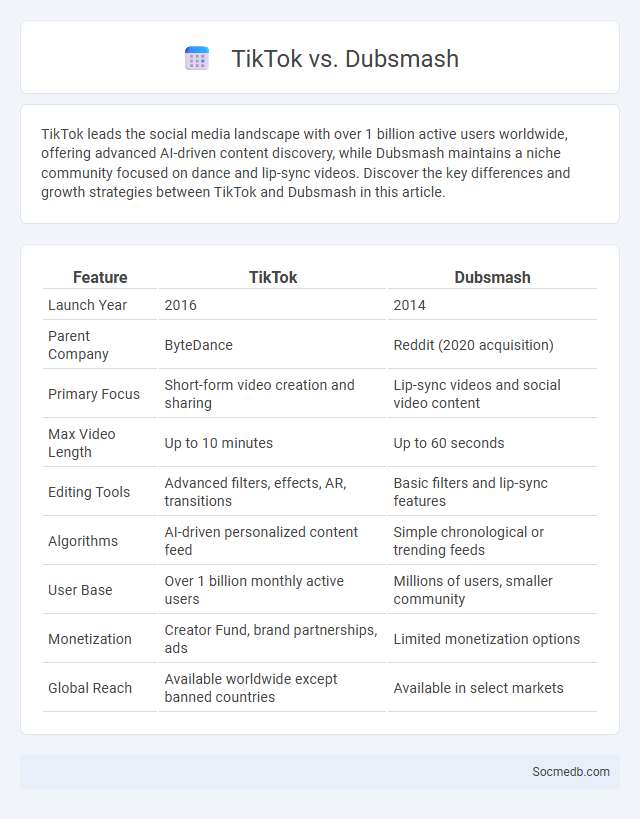
Photo illustration: TikTok vs Dubsmash
TikTok leads the social media landscape with over 1 billion active users worldwide, offering advanced AI-driven content discovery, while Dubsmash maintains a niche community focused on dance and lip-sync videos. Discover the key differences and growth strategies between TikTok and Dubsmash in this article.
Table of Comparison
| Feature | TikTok | Dubsmash |
|---|---|---|
| Launch Year | 2016 | 2014 |
| Parent Company | ByteDance | Reddit (2020 acquisition) |
| Primary Focus | Short-form video creation and sharing | Lip-sync videos and social video content |
| Max Video Length | Up to 10 minutes | Up to 60 seconds |
| Editing Tools | Advanced filters, effects, AR, transitions | Basic filters and lip-sync features |
| Algorithms | AI-driven personalized content feed | Simple chronological or trending feeds |
| User Base | Over 1 billion monthly active users | Millions of users, smaller community |
| Monetization | Creator Fund, brand partnerships, ads | Limited monetization options |
| Global Reach | Available worldwide except banned countries | Available in select markets |
Introduction to Short-Form Video Apps
Short-form video apps like TikTok, Instagram Reels, and YouTube Shorts revolutionize content creation by offering users the ability to produce engaging videos lasting from 15 to 60 seconds. These platforms employ advanced algorithms that personalize feed recommendations based on user interactions, maximizing reach and engagement. Brands leverage these apps to capture attention quickly and foster viral marketing campaigns targeting younger demographics accustomed to fast-paced digital content.
TikTok: Features, Strengths, and User Demographics
TikTok's short-form video format and advanced AI-driven content recommendation system create highly engaging user experiences that boost time spent on the app. Key strengths include viral challenges, creative editing tools, and a diverse creator community, making it a dominant platform for Gen Z and young millennials. The app's user demographics skew heavily towards ages 16-24, with over 60% of its audience in this age group, emphasizing its impact on youth culture and trends.
Dubsmash: Unique Selling Points and Market Presence
Dubsmash excels with its innovative short-form video creation tools that emphasize lip-syncing and dance challenges, attracting a diverse and engaged global user base. Its strong community features, including trending sound clips and easy sharing options, differentiate it from competitors like TikTok and Instagram Reels. The app's strategic focus on youthful audiences in emerging markets has significantly expanded its market presence and brand visibility worldwide.
User Engagement: Comparing TikTok and Dubsmash
TikTok and Dubsmash both excel in user engagement through short-form video content, but TikTok's algorithm-driven personalized feed significantly boosts viewer interaction and content discovery. TikTok reports millions of daily active users spending an average of 95 minutes per day on the app, fostering higher engagement rates compared to Dubsmash, which has a smaller but dedicated user base focused on lip-sync and dance videos. For your content strategy, leveraging TikTok's dynamic engagement features like duets and trending challenges can maximize your visibility and audience interaction.
Content Creation Tools and Editing Capabilities
Content creation tools empower you to produce engaging social media posts with features like templates, filters, and customizable graphics that enhance visual appeal. Advanced editing capabilities, including video trimming, color correction, and animation effects, enable precise adjustments that optimize content for various platforms. Leveraging these tools improves your content quality, increases audience engagement, and drives organic growth across social media channels.
Algorithm and Content Discovery Differences
Social media algorithms prioritize personalized content by analyzing user behavior, engagement patterns, and preferences to optimize content visibility and relevance. Content discovery varies across platforms, with recommendation engines on TikTok emphasizing short-form video virality, while Instagram leverages user connections and hashtag trends for feed personalization. Differences in algorithmic focus impact user experience and content strategy, influencing how creators and brands tailor posts for maximum reach and engagement.
Cross-Platform Promotion: Strategies and Challenges
Cross-platform promotion leverages multiple social media channels like Facebook, Instagram, TikTok, and LinkedIn to amplify your brand's reach and engagement. Effective strategies include tailoring content to each platform's audience and algorithm, while maintaining consistent messaging to reinforce brand identity. Challenges involve managing varied posting schedules, tracking analytics across platforms, and adapting to frequent algorithm changes to optimize your campaign's performance.
Building Your Brand: TikTok vs Dubsmash Approaches
TikTok leverages viral short-form videos and algorithm-driven content recommendations to rapidly amplify brand visibility and engage diverse audiences, while Dubsmash emphasizes user-generated lip-sync and dance clips that foster niche community interaction. Brands on TikTok benefit from influencer collaborations and trending challenges that drive authenticity and widespread reach, whereas Dubsmash offers targeted engagement within culturally specific demographics. Combining TikTok's expansive reach with Dubsmash's focused community can create a balanced, multifaceted social media branding strategy.
Monetization and Influencer Opportunities
Social media platforms offer diverse monetization options, including sponsored posts, affiliate marketing, and direct product sales, which empower influencers to convert their follower engagement into substantial revenue streams. Influencer marketing leverages audience trust and niche expertise, making it a pivotal strategy for brands aiming to enhance visibility and drive consumer action through targeted campaigns. The rise of features like Instagram Shopping, TikTok Creator Fund, and YouTube Ad Revenue sharing exemplifies the growing ecosystem supporting content creators' financial success.
Choosing the Right Platform for Your Content Goals
Selecting the ideal social media platform hinges on understanding your content goals and target audience demographics. Visual-centric content thrives on Instagram and TikTok, while professional and B2B content performs better on LinkedIn. Analyzing platform engagement metrics and user behavior ensures alignment with your marketing objectives for maximum reach and impact.
 socmedb.com
socmedb.com